Hot Chips 2018: Intel on Graphics Live Blog (11:30am PT, 6:30pm UTC)
by Ian Cutress on August 20, 2018 2:25 PM EST- Posted in
- CPUs
- Intel
- Radeon
- Hot Chips
- GPUs
- Trade Shows
- Live Blog
- Vega
- RX Vega
- Kaby Lake-G
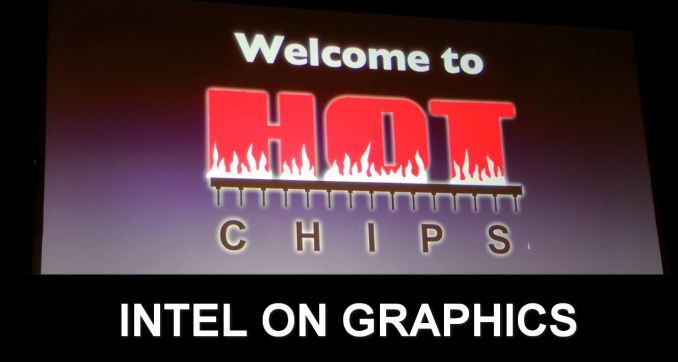
02:21PM EDT - Intel is talking graphics! We're expecting a lot of discussion about Kaby Lake G, with Radeon graphics, however the slide deck is going to talk a lot about power distribution methods in order to support the chip.
02:24PM EDT - Should start in a few minutes
02:30PM EDT - Presenter has worked on AES-NI and SSSE3
02:31PM EDT - Lead architect of Kaby G
02:31PM EDT - One of the most interesting products at Intel
02:32PM EDT - Combine high-end gaming with thin and light devices
02:32PM EDT - Aim to bridge the divide between thin and light and DTR
02:32PM EDT - A multi-generational project (!) (!)
02:33PM EDT - Kaby Lake-G
02:33PM EDT - About using multiple chips for an innovative product
02:33PM EDT - Kaby Lake processor, Radeon graphics, HBM2
02:34PM EDT - There's a framed version of the agreement with AMD at HQ
02:34PM EDT - HBM2 was customized to Intel's needs
02:34PM EDT - Enable VR in mobile form factor
02:34PM EDT - Mobile form factor meant no GDDR
02:35PM EDT - First high-volume mobile part with HBM
02:35PM EDT - 9 Displays
02:35PM EDT - NUC can access all these displays
02:36PM EDT - 'How did we make this happen'
02:36PM EDT - EMIB and DPTF
02:36PM EDT - Integration options
02:36PM EDT - MCP, Interposer, or EMIB
02:37PM EDT - Intel uses MCP for CPU to GPU, and EMIB for GPU to HBM
02:38PM EDT - For non-high density connectivity, use package. For density, use EMIB
02:38PM EDT - Large number of wires and data in low power with EMIB
02:39PM EDT - EMIB allows different geometries, different manufacturers, all in one package
02:39PM EDT - Several constraints
02:39PM EDT - Taking off-the-shelf components (minimal changes)
02:39PM EDT - Connections had to be PCIe
02:39PM EDT - in discrete form
02:40PM EDT - Normally routing length for PCIe is 8-inches
02:40PM EDT - Did a lot of simulation on 2 inches
02:40PM EDT - z-height challenges
02:40PM EDT - for heatsink
02:40PM EDT - HBM2 at 700 microns, taller than the other components
02:40PM EDT - had to be thinned in a custom manner for Intel
02:41PM EDT - Independent testing and then assembly
02:41PM EDT - 'Logistical Nightmare'
02:41PM EDT - Now Dynamic Platform Thermal Framework
02:42PM EDT - Power management controls UX
02:42PM EDT - OEMs design to SDP, not combined TDP
02:42PM EDT - Maximising perf while minimizing thermal issues
02:43PM EDT - Low latency too
02:43PM EDT - Everything is controlled to minimize power where it is not needed
02:43PM EDT - Keep power at peak given thermal contraints
02:44PM EDT - Depending on the starting thermals, more performance based on turbo
02:44PM EDT - Take advantage based on thermal characteristics
02:44PM EDT - Make sure CPU freq is scaled back if not needed
02:45PM EDT - Throttle back components that aren't needed for perf / workload
02:45PM EDT - Add discrete GPU like graphics into mix in thin and light
02:45PM EDT - provide hooks in the form of power budget for components to manage
02:46PM EDT - power policies can be used with the control mechanisms in the platform
02:46PM EDT - No shared interfaces between the parts
02:46PM EDT - Software power management solution
02:46PM EDT - Time constraints in seconds, so software is applicable
02:46PM EDT - 100ms control loop latency
02:47PM EDT - allows turbo similar to Turbo Boost 2.0
02:47PM EDT - Form factor allows the vendors to physically create thin+light or more performant form factors vs discrete graphics
02:47PM EDT - 4GB of HBM2, 1.7mm z-height
02:48PM EDT - Space savings vs GDDR5
02:49PM EDT - OEMs design for 62.5W SDP if this was traditional
02:49PM EDT - Not utilizing full spectrum of power
02:49PM EDT - No way to transfer power
02:50PM EDT - Now describing FIVR for single chip
02:50PM EDT - For discrete GPU, can't do FIVR
02:50PM EDT - but in a single package, can still power (but not as finely)
02:50PM EDT - Similar power sharing power methodology to FIVR at high level
02:50PM EDT - Up to the OEM to determine how to harness the capabilities
02:51PM EDT - design to a power, let the power sharing manage the rest
02:51PM EDT - Compare 15W i7-U plus GTX 1060 with 45W Kaby G with 55-65W Radeon
02:52PM EDT - New design allows Intel be more creative
02:52PM EDT - Faster time to market window
02:52PM EDT - From time made to decision to product was effectively 4.5 quarters
02:53PM EDT - Taking proven silicon and putting them together
02:53PM EDT - Had 90% perf on first boot, rest of tuning
02:53PM EDT - EMIB provides a path to higher bandwidth at lower pwoer
02:54PM EDT - Q&A Time
02:55PM EDT - Q: Have EMIB for HBM to GPU, but no EMIB from CPU to GPU?
02:55PM EDT - A: We use PCIe - doesn't need the density of EMIB for signalling, but you need it for HBM
02:56PM EDT - Q: GPU is Custom?
02:56PM EDT - A: We customized how the HBM interfaced with EMIB
02:57PM EDT - Q: EMIB for heterogeneous - only showing core to HBM. What's the plan for Core to Accelerator ?
02:58PM EDT - A: EMIB is technology - need to create a standardized ecosystem. Intel is actively working on this with DARPA Open Chips. But ecosystem requires a village, not one vendor. We're showing the potential, needs more players
02:59PM EDT - Q: Learned about integration - any more insights into same die ? A: Depends on wires being pulled out. High bandwidth is better on chip, need to evaluate ROI on power.
OK that's a wrap. Our next talk is AMD: https://www.anandtech.com/show/13243


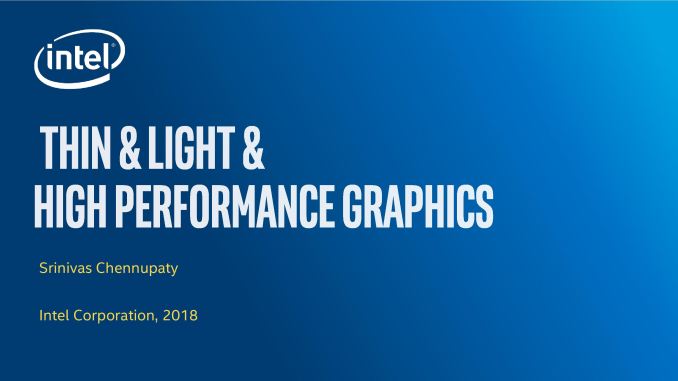
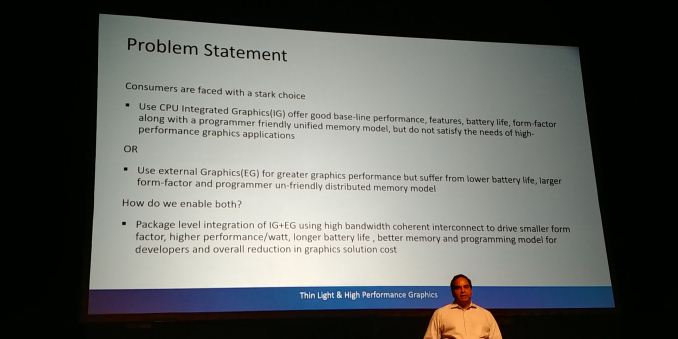
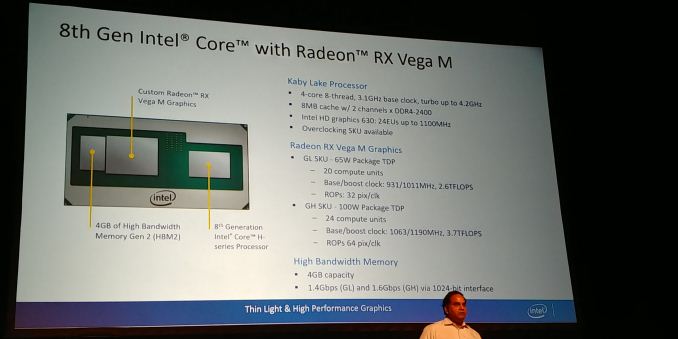
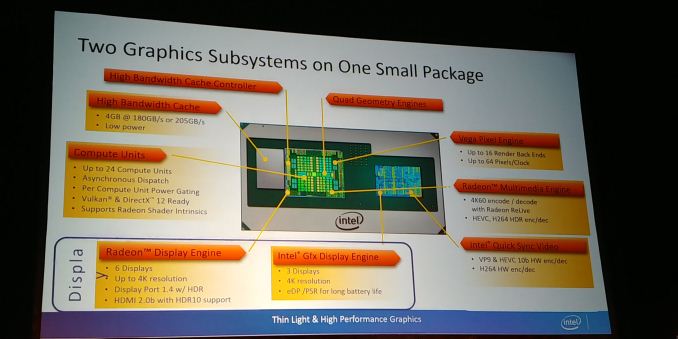
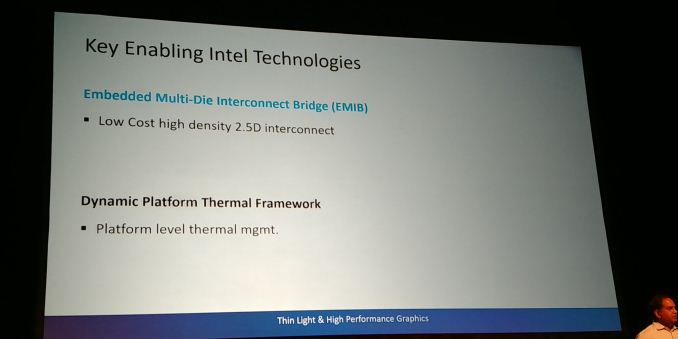
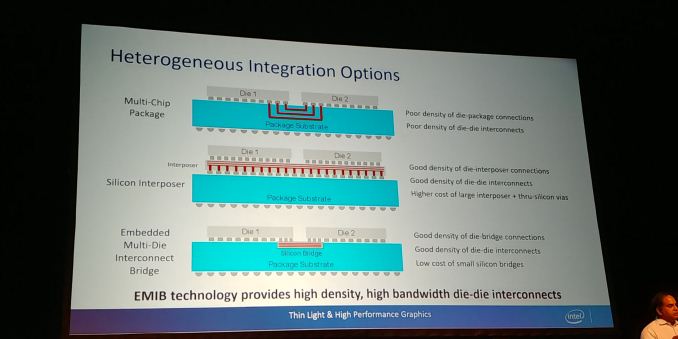
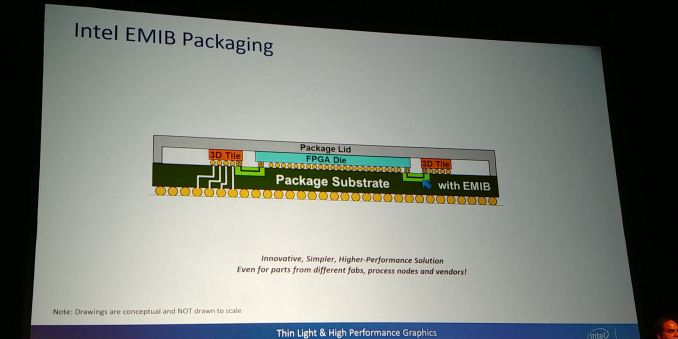

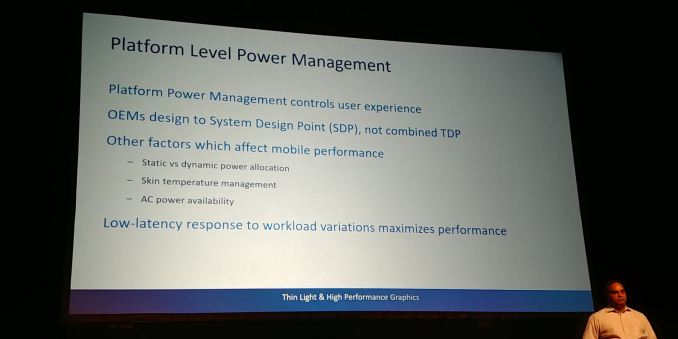

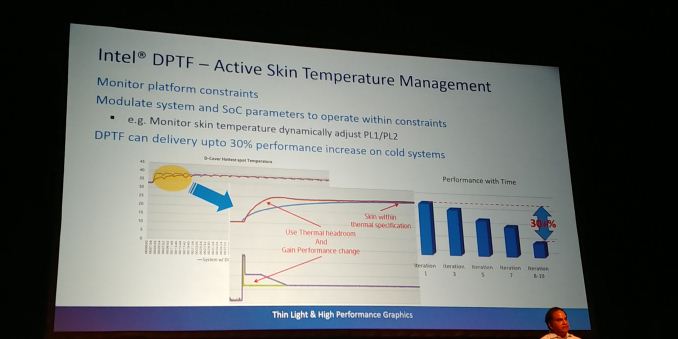
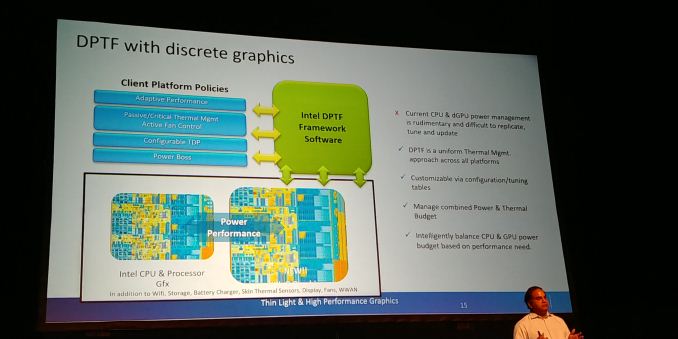

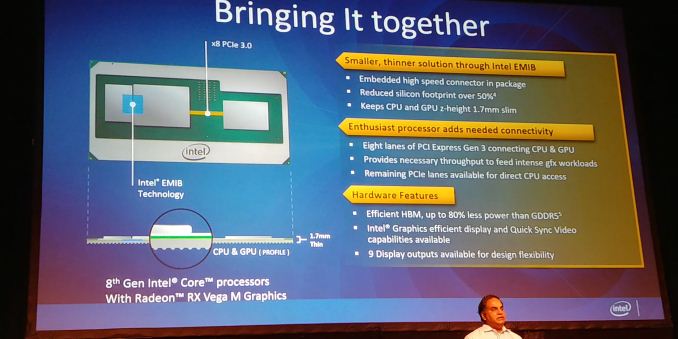
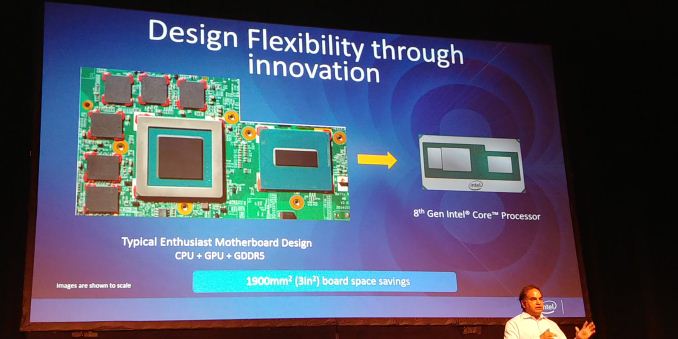
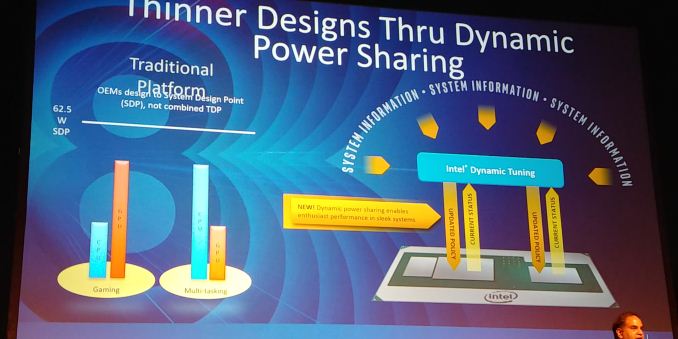
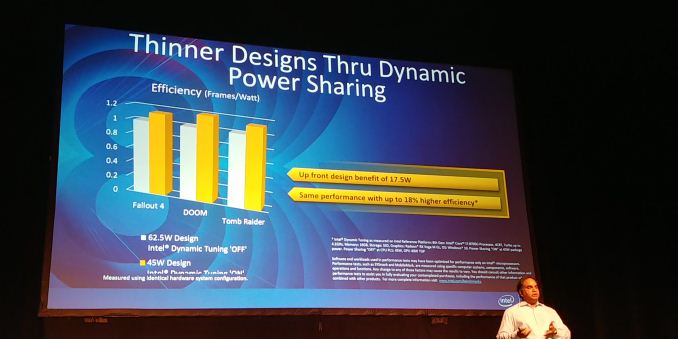

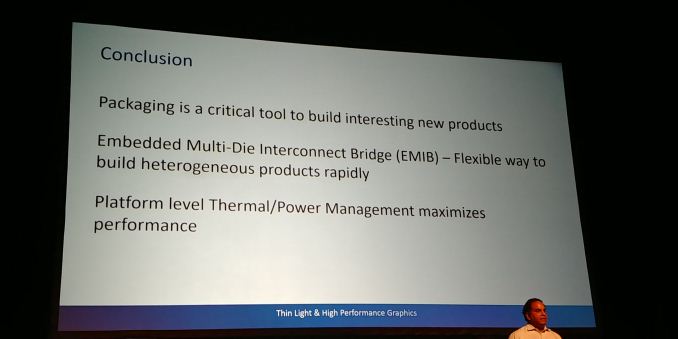








8 Comments
View All Comments
HStewart - Monday, August 20, 2018 - link
Thanks for information provided here. I got my Dell XPS 15 2in1 and it does not support HDR10 or 9 monitors - so I am not sure about it - but appear that Display output is not working on AMD GPU. But I still impressed with performance of the box.One thing I am impressed with the technology of EMIB, I have a feeling that Intel is planning on using this for their own GPU's (Artic Sound) possible other GPU's coming in the future - either from AMD or even NVidia.
Santoval - Tuesday, August 21, 2018 - link
Yes, EMIB would be ideal to link 2 or 4 GPU dies together, which would be much cheaper than huge monolithic dies. It has a much higher bandwidth and much lower latency than Infinity Fabric.HStewart - Tuesday, August 21, 2018 - link
Also the fact that EMIB would also be so much thinning - which is good for Laptop. I would not doubt it could even be use for desktops and servers.I am thinking it would be perfect for such devices as iMac / iMac Pros and such.
I see EMIB having truly almost infinite possibilities one day
1. Discrete GPU (s) even more than one - imagine even one day once technology is there SLI on a notebook in single package
2. Multiple CPU and GPU in single package.
Of course you build multiple motherboard with multiple EMIB packages
It probably will never happen - because of other complexities in system, up upgradable systems.
Yojimbo - Tuesday, August 21, 2018 - link
I would think you would want to link large GPU dies together. EMIB surely is more power hungry and has lower bandwidth than intra-die transport.HStewart - Tuesday, August 21, 2018 - link
It sounds like EMIB is suppose lower power demands - but more than one GPU - maybe too much power. I would think the bandwidth would be faster on EMIB than with intra-die transport.Do you have any proof of "EMIB surely is more power hungry and has lower bandwidth than intra-die transport." ? that seems to contradict what is stated in this article in my opinion.
watersb - Tuesday, August 21, 2018 - link
Thanks for the Hot Chips coverage! Sleep is good too. :-)TETRONG - Tuesday, August 21, 2018 - link
You state that they're comparing i7U+1060 versus Kaby Lake G w, Vega GL.. but the slides state 1050.The fine print says actual Asus laptop versus Intel Reference platform, so those results are essentially meaningless anyways. We don't know the volume of the reference platform/material or how it was cooled and it's cost.
Intel says they've gone to market so quickly with this, yet they're hardly available in any shipping systems.
This is all about the GL part but wasn't there supposed to be a higher performing GH part?
This whole chip has been a disappointment.. by the time it's actually around Nvidia will have a higher performing version of the MX150 or some equivalent.
HStewart - Tuesday, August 21, 2018 - link
"Intel says they've gone to market so quickly with this, yet they're hardly available in any shipping systems."It is widely available in Dell XPS 15 2in1, I have one because I wanted a faster cpu in 2in1 form factor like my Dell XPS 13 2in1 - but It would have been probably better to wait for new Dell XPS 15 with real NVidia GPU
"This whole chip has been a disappointment.. by the time it's actually around Nvidia will have a higher performing version of the MX150 or some equivalent."
As a GPU goes the Dell XPS 15 2in1 is quite fast =GPU is ok if software use the AMD card - but overall a great product - just wish it had a better GPU.